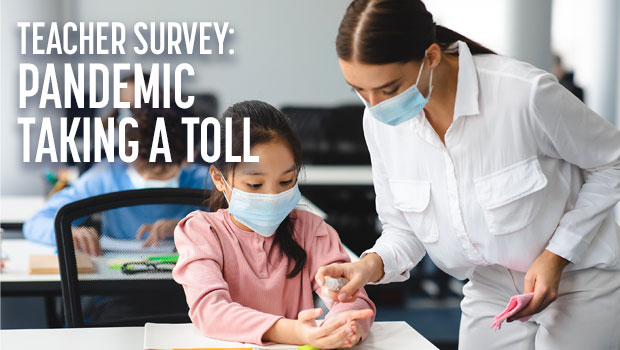New CEA Back-to-School Survey shows indoor air quality, social distancing, COVID testing top concerns leading to stress and teachers leaving the profession
Connecticut educators enthusiastically welcomed students into classrooms for in-person learning, but the emergence of the delta and mu variants at a time when there is no vaccine yet for our youngest students has teachers concerned about school safety—in particular, the lack of adequate ventilation systems, social distancing, and COVID-19 testing policies to protect students, educators, and their families.
“Our educators are excited and filled with optimism for their students and the new school year,” said CEA President Kate Dias. “We know in-person teaching is best, but we also need to do all we can to keep our school communities safe and prevent further spread of the virus.”
Uncertainty around pandemic protocols and inconsistency in school safety measures have taken a heavy toll on teachers, prompting many to consider retiring early or changing professions, which will have long-term consequences for teaching and learning in Connecticut.
A new CEA Back-to-School Survey of nearly 1,000 educators shows the top concerns for educators and the need for districts to do more to ensure safety in school communities.
- Almost all survey respondents, 97%, say improved ventilation in schools is a top safety priority, but just slightly over a quarter (27%) say improvements have actually been made to their school’s ventilation system.
- Nine out of ten educators say requiring students and staff who are close contacts of someone who tested positive for COVID-19 to quarantine and/or be tested before returning to school is a top priority. However, only 51% believe their schools are following that procedure.
- Adhering to physical distancing measures is a top priority for 80% of respondents, but only 35% say their districts are enforcing these guidelines.
- Educators also place a high priority on requiring that unvaccinated staff be tested regularly, though just over half (51%) believe this measure will be implemented in their schools.
Nearly half (47%) say their school’s ventilation system does not provide enough protection from COVID-19 for them to feel safe. More than a quarter (27%) say they feel safe, and nearly as many, (25%) are unsure.
“This survey underscores the fact that while educators want to be in school, teaching in-person, safety issues must continue to be addressed,” said CEA Executive Director Donald Williams. “High on the list of concerns is indoor air quality, because poor air quality in classrooms could lead to a spread of the virus, especially in our younger grades, where students are not yet eligible for vaccines.”
He added that not only have many schools reported positive COVID-19 cases and quarantined students and teachers in the early weeks of this school year, but dozens of schools were also forced to close because of extreme temperatures in classrooms.
“With the influx of federal Elementary and Secondary School Emergency Relief (ESSER) funds,” Williams stressed, “the state has the resources to improve the health and safety of our schools by installing, maintaining, or repairing heating, ventilation, and air conditioning systems to improve indoor air quality and provide safe teaching and learning environments.”
Stress and teacher exodus
Connecticut educators are vaccinated at a much higher rate than the general public, with 89% of those surveyed reporting that they have been vaccinated. The vast majority (79% of respondents) also support Governor Lamont’s mask requirement in schools, with 60% saying enforcing the mandate with students will be easy.
Teaching, however, remains one of the most stressful professions—a trend exacerbated by the pandemic.
On a scale of zero to ten, pre-pandemic stress levels averaged around six. Last year, workplace stress was 8.7 out of ten, and teachers expect their stress levels to remain above eight this year.
“Teaching is stressful, and that stress can take a major toll on educators’ mental health,” said Dias. “We continued teaching while facing great uncertainty last year. We had to learn new technology, new platforms, and new teaching styles with little or no preparation, and then we were required to teach both in-person and remote students concurrently. That’s equivalent to teaching two classes simultaneously, and we know that dual teaching is unsustainable, unsound, and flawed. It is a lose-lose scenario for both in-person and remote leaners, as well as teachers, who cannot be expected to do two separate jobs at once.”
Pandemic stress, combined with the unrealistic demands being put on teachers, is leading to shortages in the profession, Dias noted.
According to the survey, the COVID-19 pandemic has prompted more than one-third of educators to think about retiring or leaving the profession earlier than planned.
“Educators are professionals, and when they aren’t treated as professionals or they are not allowed to have input on critical issues that affect students and public education policy, including health and safety concerns, they are going to look for work elsewhere, where stress levels are lower, pay is higher, and they receive the respect they deserve. We have to seriously examine long-term impacts to the teaching pool and look at the shortage of students entering teacher preparation programs.”
Nearly 1,000 CEA members responded to the statewide poll conducted August 20-25, 2021, by GBAO Strategies in Washington, D.C.







